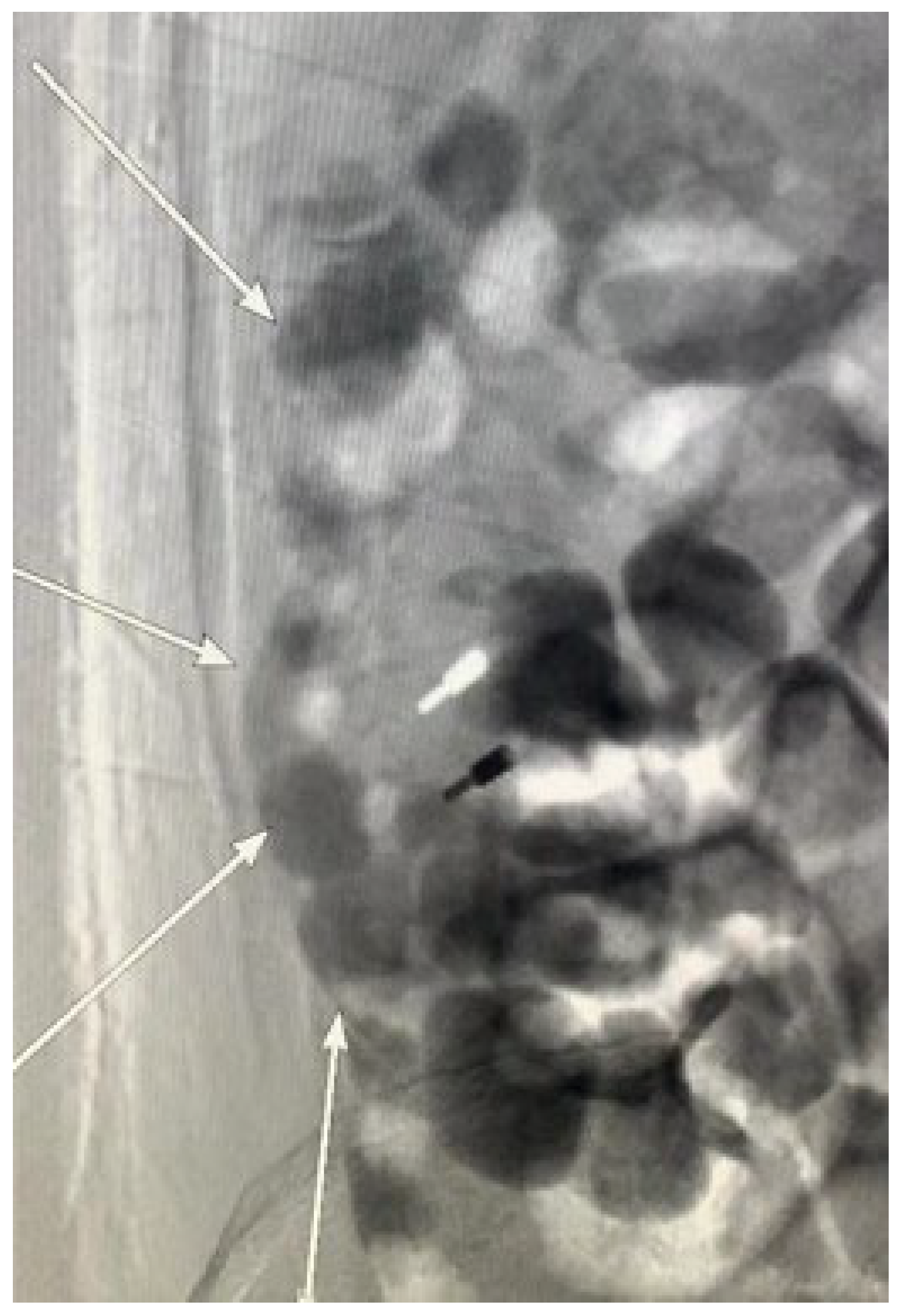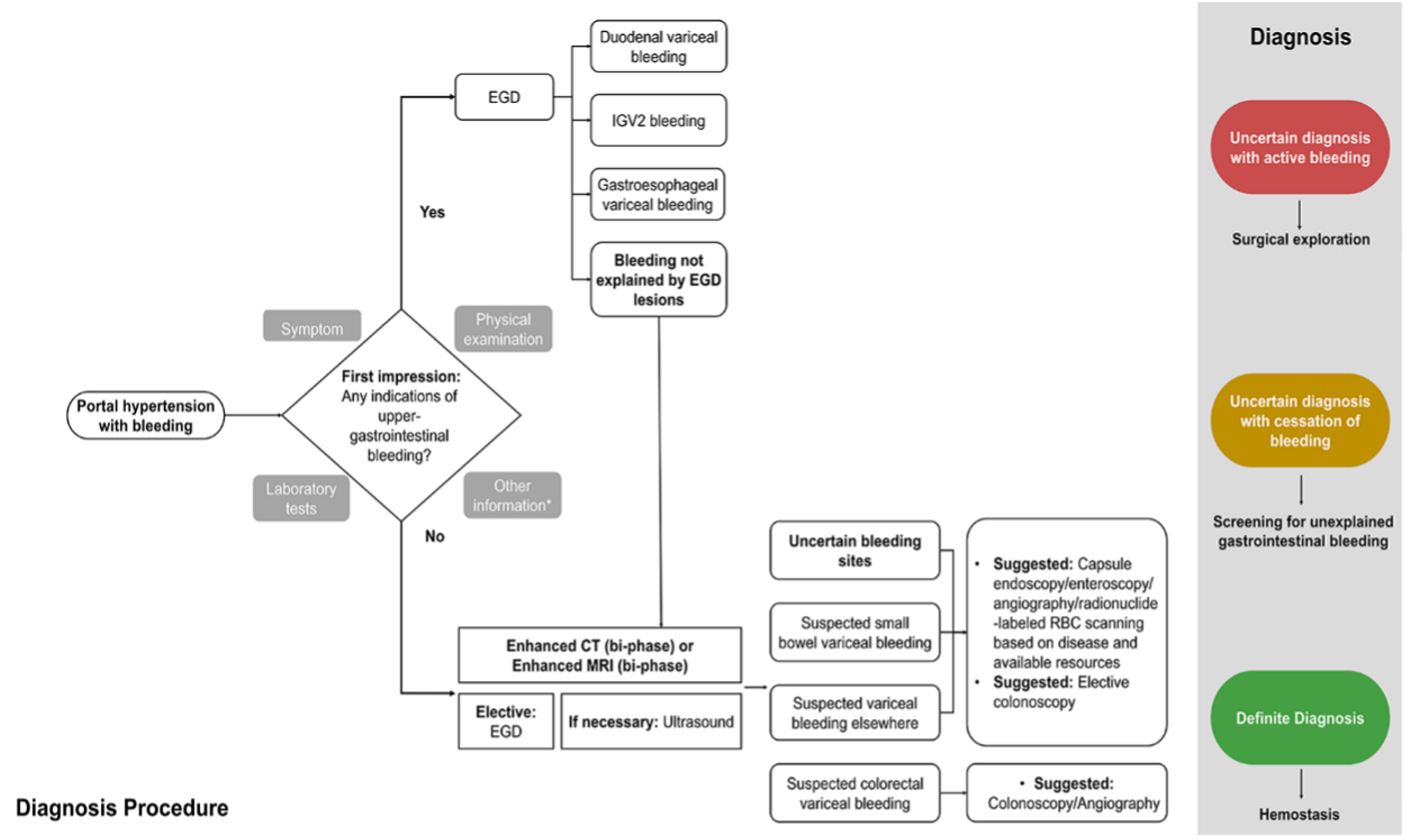Less Could Be More: Rethinking the Unexpected Deterioration of Variceal Bleeding After Endoscopic Occlusion of Gastroesophageal Varices
Abstract



Author Contributions
Funding
Institutional Review Board Statement
Informed Consent Statement
Data Availability Statement
Conflicts of Interest
References
- Watanabe, N.; Toyonaga, A.; Kojima, S.; Takashimizu, S.; Oho, K.; Kokubu, S.; Nakamura, K.; Hasumi, A.; Murashima, N.; Tajiri, T. Current status of ectopic varices in Japan: Results of a survey by the Japan Society for Portal Hypertension. Hepatol. Res. 2010, 40, 763–776. [Google Scholar] [CrossRef] [PubMed]
- Park, S.W.; Cho, E.; Jun, C.H.; Choi, S.K.; Kim, H.S.; Park, C.H.; Rew, J.S.; Cho, S.B.; Kim, H.J.; Han, M.; et al. Upper gastrointestinal ectopic variceal bleeding treated with various endoscopic modalities: Case reports and literature review. Medicine 2017, 96, e5860. [Google Scholar] [CrossRef] [PubMed]
- Shiraishi, M.; Hiroyasu, S.; Higa, T.; Oshiro, S.; Muto, Y. Successful management of ruptured duodenal varices by means of endoscopic variceal ligation: Report of a case. Gastrointest. Endosc. 1999, 49, 255–257. [Google Scholar] [CrossRef] [PubMed]
- Al Khalloufi, K.; Laiyemo, A.O. Management of rectal varices in portal hypertension. World J. Hepatol. 2015, 7, 2992–2998. [Google Scholar] [CrossRef] [PubMed]
- Coelho-Prabhu, N.; Baron, T.H.; Kamath, P.S. Endoscopic band ligation of rectal varices: A case series. Endoscopy 2010, 42, 173–176. [Google Scholar] [CrossRef] [PubMed]
- Liu, Y.; Yang, J.; Wang, J.; Chai, G.; Sun, G.; Wang, Z.; Yang, Y. Clinical characteristics and endoscopic treatment with cyanoacrylate injection in patients with duodenal varices. Scand. J. Gastroenterol. 2009, 44, 1012–1016. [Google Scholar] [CrossRef] [PubMed]
- Sharma, M.; Somasundaram, A. Massive lower GI bleed from an endoscopically inevident rectal varices: Diagnosis and management by EUS (with videos). Gastrointest. Endosc. 2010, 72, 1106–1108. [Google Scholar] [CrossRef] [PubMed]
- So, H.; Park, D.H.; Jung, K.; Ko, H.K. Successful Endoscopic Ultrasound-Guided Coil Embolization for Severe Duodenal Bleeding. Am. J. Gastroenterol. 2016, 111, 925. [Google Scholar] [CrossRef] [PubMed]
- Kulkarni, A.; Nair, A.; Mehta, S.; Bhaware, B.; Mukewar, S.; Mukewar, S. Never say never: A novel approach to tackle a bleeding ectopic varix. Endoscopy 2024, 56, E801–E802. [Google Scholar] [CrossRef] [PubMed]
- Rana, S.S.; Sharma, R.; Gupta, R. Refractory rectal variceal bleeding treated with EUS-guided coil embolization. Endosc. Ultrasound 2021, 10, 141–142. [Google Scholar] [CrossRef] [PubMed]
- Sharma, M.; Rai, P.; Bansal, R. EUS-Assisted Evaluation of Rectal Varices before Banding. Gastroenterol. Res. Pract. 2013, 2013, 619187. [Google Scholar] [CrossRef] [PubMed]
- He, K.; Pang, K.; Yan, X.; Wang, Q.; Wu, D. New sights in ectopic varices in portal hypertension. Qjm 2024, 117, 397–412. [Google Scholar] [CrossRef] [PubMed]
- Tranah, T.H.; Nayagam, J.S.; Gregory, S.; Hughes, S.; Patch, D.; Tripathi, D.; Shawcross, D.L.; Joshi, D. Diagnosis and management of ectopic varices in portal hypertension. Lancet Gastroenterol. Hepatol. 2023, 8, 1046–1056. [Google Scholar] [CrossRef] [PubMed]
- Garcia-Tsao, G.; Abraldes, J.G.; Berzigotti, A.; Bosch, J. Portal hypertensive bleeding in cirrhosis: Risk stratification, diagnosis, and management: 2016 practice guidance by the American Association for the study of liver diseases. Hepatology 2017, 65, 310–335. [Google Scholar] [CrossRef] [PubMed]
- Bhagani, S.; Winters, C.; Moreea, S. Duodenal variceal bleed: An unusual cause of upper gastrointestinal bleed and a difficult diagnosis to make. BMJ Case Rep. 2017, 2017, bcr2016218669. [Google Scholar] [CrossRef] [PubMed]
Disclaimer/Publisher’s Note: The statements, opinions and data contained in all publications are solely those of the individual author(s) and contributor(s) and not of MDPI and/or the editor(s). MDPI and/or the editor(s) disclaim responsibility for any injury to people or property resulting from any ideas, methods, instructions or products referred to in the content. |
© 2025 by the authors. Licensee MDPI, Basel, Switzerland. This article is an open access article distributed under the terms and conditions of the Creative Commons Attribution (CC BY) license (https://creativecommons.org/licenses/by/4.0/).
Share and Cite
Pang, K.; He, K.; Min, Y.; Wang, Z.; Wu, D. Less Could Be More: Rethinking the Unexpected Deterioration of Variceal Bleeding After Endoscopic Occlusion of Gastroesophageal Varices. Diagnostics 2025, 15, 461. https://doi.org/10.3390/diagnostics15040461
Pang K, He K, Min Y, Wang Z, Wu D. Less Could Be More: Rethinking the Unexpected Deterioration of Variceal Bleeding After Endoscopic Occlusion of Gastroesophageal Varices. Diagnostics. 2025; 15(4):461. https://doi.org/10.3390/diagnostics15040461
Chicago/Turabian StylePang, Ke, Kun He, Yiyang Min, Zhiwei Wang, and Dong Wu. 2025. "Less Could Be More: Rethinking the Unexpected Deterioration of Variceal Bleeding After Endoscopic Occlusion of Gastroesophageal Varices" Diagnostics 15, no. 4: 461. https://doi.org/10.3390/diagnostics15040461
APA StylePang, K., He, K., Min, Y., Wang, Z., & Wu, D. (2025). Less Could Be More: Rethinking the Unexpected Deterioration of Variceal Bleeding After Endoscopic Occlusion of Gastroesophageal Varices. Diagnostics, 15(4), 461. https://doi.org/10.3390/diagnostics15040461





